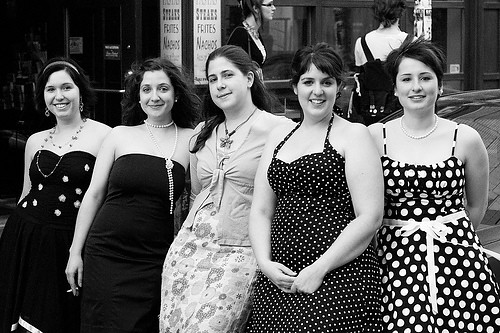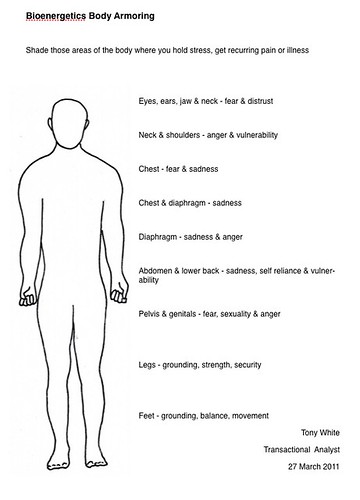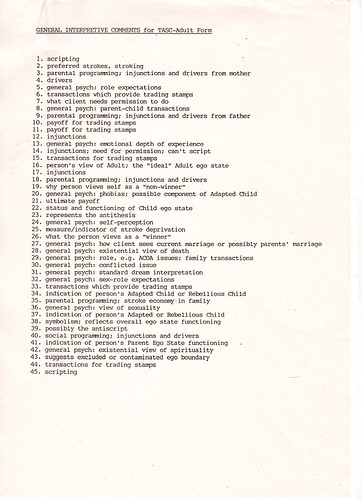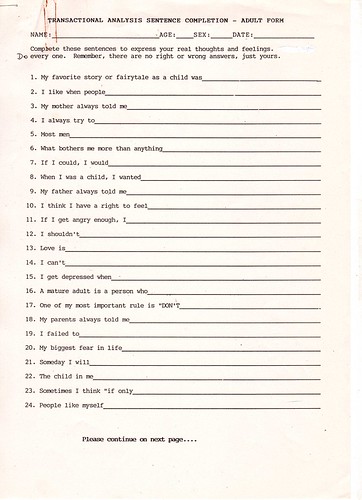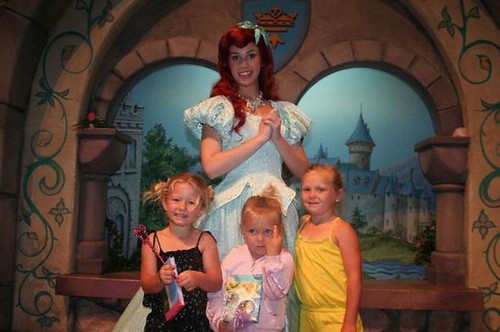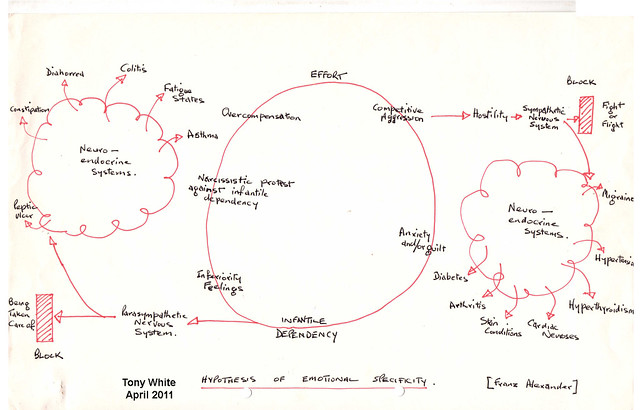The various forms fantasy can take.
Fantasy as a defence mechanism.
As originally posited by Freud many, many years ago fantasy can be used as a defence mechanism. A defence mechanism is meant to defend a person from anxiety producing stimuli. It is designed to keep their sense of self intact when confronted with unpleasant information.
The example often used to demonstrate this defence mechanism comes from James Thurber’s tale, “The secret life of Walter Mitty”. He was a meek man dominated by a bullying wife. Such a situation would damage anyone’s self esteem. He copes with it by escaping into daydreams where he does heroic deeds as a sea captain or knight in shining armour. This allowed his self respect to be saved at least while he was daydreaming.

They do not have to be heroic deeds, it may be fantasising of a lovely place or a relationship that brings good feelings. If fantasy is used as an escape from painful information in real life then the fantasy may be a defence mechanism.
The young child who has to deal with loud parental arguments can do so by going into withdrawal and daydreaming. The Free Child ego state deals with the anxiety by simply thinking about something else and thus the anxiety reduces.
Kahless provided us with an example of her daydreams. This is a good example which shows a number of interesting features.
“My day dreams generally revolve around me performing a heroic but fatal deed.
I used to day-dream being a secret agent, or a fireman, or Lara Croft.
These days I am just me. This very morning I day-dreamed that I was at work, in a meeting and armed gun-men stormed in. They said they would release everyone if someone volunteered to play russian roulette. I volunteered. I looked them in the eye and said "come on then fuckers."
I fantasise aka day-dream, a lot.
In real life, people around me say I am courageous. I think I am and I am not. Sometimes I like to just plain put my head in the sand.
Maybe this links into my blog name and my avatar.
Kahless - a Klingon warrior
and a lion who maybe from the Wizard of Oz.” (end quote)

In working with such a person there is no direct sign here that the daydreaming is being used to avoid painful circumstances. One would need to enquire as to that. The fact that she reports daydreaming a lot is a sign that she may be using fantasy as a defence mechanism.
Fantasy in the schizoid personality structure
Fantasy can be an important part of the schizoid personality type. That person who is socially isolated and does not have much interest in being otherwise. That is they do not crave a lot of social contact and are OK being a ‘loner’. One would be enquiring from the above example about their social life and desire to form relationships. If there is little interest in social contact then the fantasising could be seen as one way by which the individual copes. A rich fantasy life allows the person to psychologically withdraw and obtain the strokes they need at least to survive. The schizoid person is commonly stroked deprived as a result of little social contact. The fantasies can provide some level of strokes for them.
Of course the person who uses fantasy as a defence mechanism can also use fantasy as part of their schizoid personality structure. But this is by no means always the case. The defence mechanism of fantasy may be used in quite specific circumstances to deal with difficult circumstances and then the fantasising ceases. The schizoid personality who uses fantasy does so in a far more wide ranging way. They may fantasise as a defence mechanism but they will also fantasise when there is nothing to defend against. The schizoid is a withdrawn type of person and the fantasising is used to facilitate that withdrawal.

It is reported in the example that she daydreams a lot so one would be questioning about other features of the schizoid personality type so as to make a judgement on that diagnosis.
Fantasy to alter mood
It would seem that fantasy could operate in both ways, to provide for a pleasant mood and have a self soothing effect and to be used to provide angst and emotional disquiet.
It is probably safe to say that the majority of fantasy is used to self soothe. The fantasizer uses it to generate a more positive mood. The most obvious example of this is with sexual fantasies, however there are many other kinds of fantasies which could do the same. Any fantasy that has desirable content could be seen to achieve a self soothing effect. Indeed in therapy people who have trouble self soothing can use the soothing effects of fantasy as a means to start learning how to self soothe. Certainly a good skill to have.
The fantasy example we were provided with by Kahless states:
“I dont use day dreams to defend against anxiety, but I guess in the main I do daydream for self gratification”(end quote)
and
“I will drift mostly into daydream I think when I am bored. That is particularly when driving, or sat in a meeting at work that has lost my attention or when the tv is on.”(end quote)
Thus indicating the use of fantasy to self soothe and generate a more positive mood.

However there are perhaps two exceptions to this where undesirable content in the fantasy can also have a soothing effect. The first I talk about in my book - Working with suicidal individuals - when I mention suicide fantasies and their potential self soothing effects.
The client who reported as an 8 year old child she used to sing the rhyme, “I wish I was dead, I wish I was dead”. She had developed a rudimentary suicidal fantasy that allowed her to feel better when under stress at home. She used it to soothe painful feelings as it gave her a fantasised escape hatch from a very undesirable domestic situation.
Then a case study was presented on the topic of escape hatches.
“Having the (suicide) option there in the back of my head actually serves to help me. It doesn't help once the danger is more immediate. When it starts making messes. But on a day to day basis it is nice.
It helps with the more minor bad things like 'yes this situation is bad, but it's not quite bad enough to kill myself over, which if it does get worse is an option.'
I visualize the (suicide) method in my head a lot though during times of stress. It's soothing”
(End quote)

Second we have what amounts to fantasised self harm. I wrote this some time ago on another blog.
A 27 year old male reports that when he gets very down he will create visual scenarios (fantasies) in his mind. Typically he does this when he goes to bed at night. They are very violent and always involve him getting hurt. For instance he imagines himself being stabbed or shot by someone else or he will imagine himself shooting, stabbing or cutting himself with big knives. In essence we have fantasised self harm.
Self harm in an ironic kind of way is about self soothing. Most often people self harm because it makes them feel better at least partially (as well as distressed by it often). They are in some important way soothed by it. This man reports that such fantasies make him feel better afterwards. He feels a sense of relief and he finds that it relaxes him and reduces the tension he was feeling previously. This is typically reported by some self harmers.
Above describes how some people use fantasy to change their mood in a positive way where they end up feeling better. Some use fantasy for the opposite reason where they end up feeling worse.
Fantasy and strokes
This in transactional analysis relates to stroke theory. In childhood people develop their stroking patterns then compulsively repeat the same kind of stroking patterns in adulthood. If they tended to receive positive strokes in childhood they will set about receiving the same in adulthood through the way they relate, by the activities they do and by the fantasies they have. If they tended to receive negative strokes in childhood they will do the same in adulthood in the same way including the fantasies they have. In these circumstances the fantasy is used to change the mood in a more painful direction.
Fantasy can be quite a powerful way to obtain strokes because they can be achieved at any time and are guaranteed (completely reliable). They are not dependent on some other person doing something. The outcome is completely dependent on the fantasizer and no other person or set of circumstances.

Fantasy and life script reinforcement
Related to this is the concept of reinforcing memories. In Transactional Analysis theory people are said to have a collection of reinforcing memories that will reinforce their perceptions of self and others. For example if a person is somewhat paranoid and believes you cannot trust others he will have a collection of reinforcing memories to support that belief. As he goes through life he will collect (maintain recall) those experiences when his trust was broken or he saw people behave in untrustworthy ways. He will conveniently forget or loose the recall of those experiences where people behaved in trustworthy ways. This makes his world reliable and consistent with the conclusions he has made about it. that you cannot trust people.
Fantasy can be used in the same way. If one is constantly hearing stories of betrayal and disloyalty that will over time take its toll. Even though they are fictional tales it can still support the early decisions in a kind of clandestine way. As an example one needs only to look at the psychology of the narcissistic personality. One of the diagnostic criteria in the DSM for the narcissist is:
“Preoccupation with fantasises of unlimited success, power, brilliance, beauty, or ideal love.”
This begins to show some of the psychological power that fantasies can have in the human psyche. One could argue that they are of little importance because they are fictional and thus they will be dismissed as having any meaning for the person’s psychology. However as the DSM indicates it has been discovered that a significant number of narcissists will fantasise in a way that is consistent with the beliefs of their exceptional worth, importance, specialness and so forth. The fantasies support the personality structure of these individuals.

However it must also be remembered that people use fantasy for a variety of reasons and this is just one of them.
For instance we can go back to the example provided by Kahless where she states:
“My day dreams generally revolve around me performing a heroic but fatal deed.
I used to day-dream being a secret agent, or a fireman, or Lara Croft.” (end quote)
We know from her comments in final fantasy 4 (Edit #1) where she states:
“I think I would tend to have schizoid characteristics. Incidentally my partner a number of times these last weeks has commented on how cold and distant I have been lately.” (end quote)
She is not of a narcissistic personality but reports fantasies that one could find from the narcissistic type of person. She is fantasising heroic deeds for some other reason than to support a narcissistic personality structure.
The point at hand is to ascertain from the client does the fantasy have any meaning for them in terms of supporting their life script beliefs. If this is the case then various treatment options open up with the use of fantasy. Give the narcissistic client homework where they fantasise self as just an average citizen. Or even do a guided fantasy with such an individual where there is nothing exceptional about them. This is similar with the treatment options of getting a person to change their reinforcing memories. The same could apply by getting the person can change their reinforcing fantasies.
There are still more reason what people fantasise. Watch this space.
Graffiti

